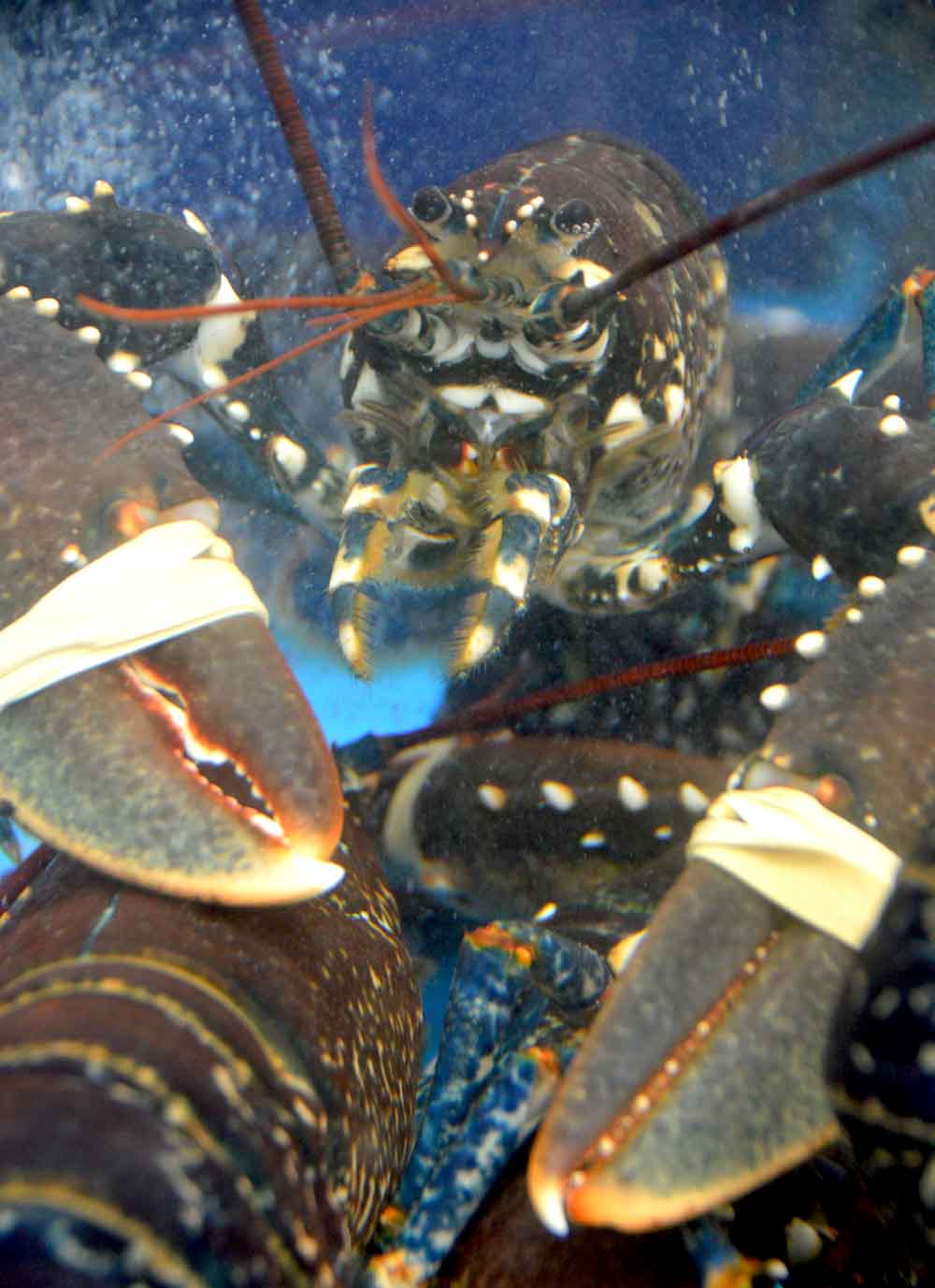Lobsters are a luxury food and not something that you eat every day. So when lobster is on your menu you want it to be the best. A lobster will be at its freshest and tastiest if you buy it live and cook it yourself.
To offer our customers the freshest lobster on the very best condition we have installed a “Homarium” in our Muswell Hill shop. This is a specialist tank that keeps the lobsters humanely in ideal conditions. You can see more here >>
You can see in our tank that before cooking the lobster shell has a dark colour, with a blue green hue – it aquires the classic red-orange colour after the cooking.
Cooking Lobster Part One
Buying a live lobster mean that it is the freshest it can possibly be but will need you to kill it before cooking. They are living creatures so they do need to be treated humanely. This is best done just before cooking. Where possible cook live lobsters on the day of purchase. They are best stored wrapped in damp newspaper or tea cloth and placed in the fridge.
Note: Never pick up a live lobster whose claws aren’t bound with an elastic band – they’re very powerful and and could do your fingers serious damage.
Note: These tips require confident use of a large knife so please take care
There are many different ways of doing this and you might have your own technique however some are more humane than others. This is a method widely recommended:
Place the lobster in your freezer for at least twenty minutes. If it is still active when removed return for a further twenty minutes. You could also place it in a container of ice for the same period. Lobsters are cold blooded and this chilling will render them unconscious. Not only are they stunned it does make them much easier to handle.
Place your lobster legs up onto a chopping board. Take a large (sturdy) knife in your right hand and grasp the tail firmly with you left. Place the tip of the knife at the point between it hindmost legs. Have the blade of the knife facing towards the head.
Push the blade tip firmly down and in a continuous motion slice through the body drawing the blade right to the front of the head. This will have the effect of severing the nervous system and killing the animal. (Lobsters do not have a centralised brain). You do not need to cut right through the body shell in this process and if you can avoid doing so will get a better presentation when cooked.
You will see that the main claws and legs go limp right away. Lobsters do have a decentralised nervous system which means that the tail and hind legs may continue to twitch despite your earlier knife cut.
Award-winning writer and editor Trevor Corson has written a great book about lobsters and has an equally good blog post on how to dispatch them humanely with some helpful photos.
If this is all more than you want to do in your own kitchen don’t worry – We have plenty of prepared lobsters in the shop.
Cooking Lobster Part Two
Boiling is the most common way of cooking lobster and the easiest. Here are our tips.
Make sure you you have a large pan that is the right size for your lobster. Fill to the 3/4 level and add plenty of salt. (The water should be salty like sea water). The lobster should be fully covered by the water.
Once your lobster is ready for cooking, place into the pan which should be boiling. As the lobster is cold the water will cool so wait until it returns to the boil then start timing on a reduced heat – keep it simmering.
Allow 15 minutes for the first 450g. Then a further 10 minutes for each additional 450g
Keep your eye on the clock. Under cooked lobster does not taste very good and over cooked it can be dry and quite tough. Whilst all lobsters will turn the familiar red orange during cooking, colour change itself does not indicate the meat is cooked – larger lobsters in particular will change colour before the inside is fully done
Serving Your Lobster
Allow the lobster to cool enough to handle comfortably
First twist/pull off the large claws. To extract the meat you will need to break open the tough shell a pair of lobster crackers made for the job will help here, you could also use nutcracker if they are sturdy. Bear in mind that you want to extract the meat in the largest pieces possible so be gentle if you resort to a hammer or rolling pin!
You can extract meat from the smaller legs if you flatten them to open the shell then use a teaspoon
For the body, split the lobster in half along its length and separate the two halves. Your earlier cut will facilitate this. The stomach and gills should all be discarded. The liver is edible and can be considered a delicacy. It is often referred to as Tomalley
The main meat is in the tail, hold the body and lift it upwards and it will detatch. Bend back the “fan” at the tail end it also will detach – the meat in this part is small but tasty so worth some effort to remove.
You now have a shell tube and you can push the meat out with your finger. Larger lobsters might need you to cut along the underside of the shell. This can be done with a knife or kitchen scissors.
Look along the top side of the tail meat and if you can see a thin blackish strip of vein it should be removed.
Serve with some melted butter or mayonnaise for dipping and some fresh bread and a small salad.
The empty shells can be used to make stock, they are typically used for lobster bisque and many other fish soups.







